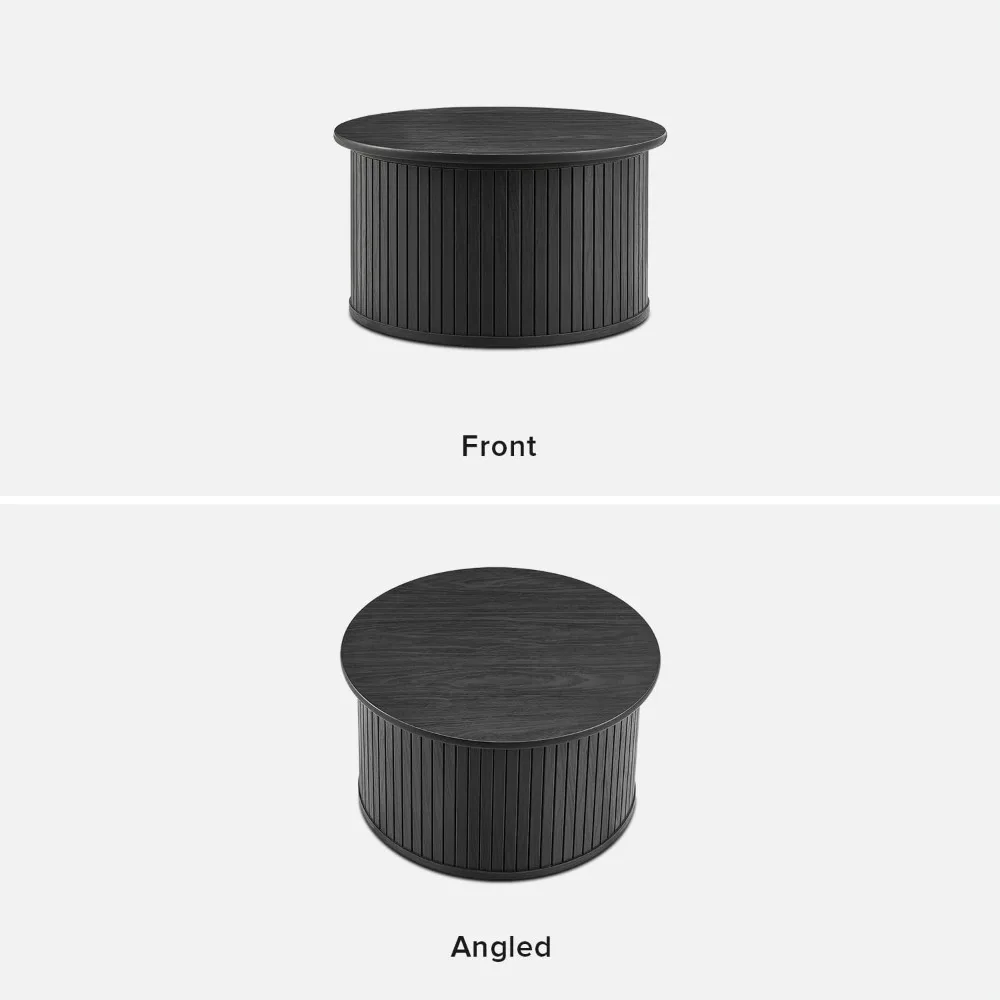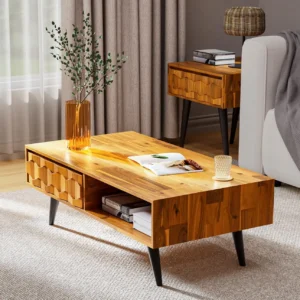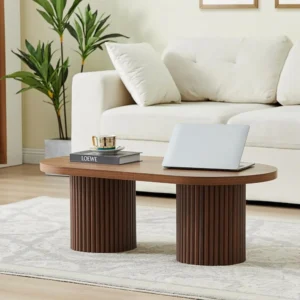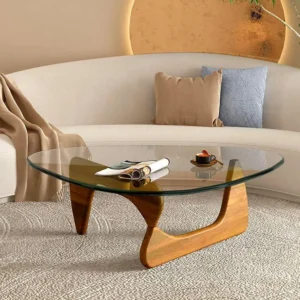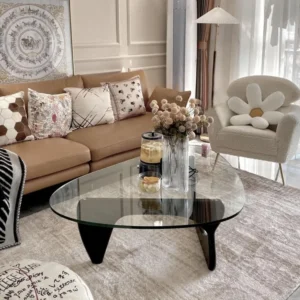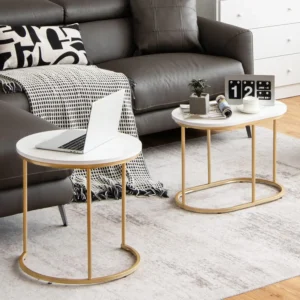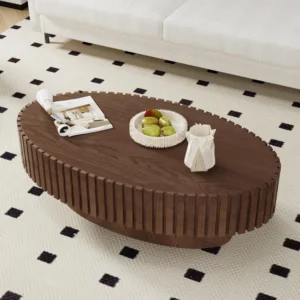Why Black Coffee Tables Thrive in Mid-Century Design
Black coffee tables have earned their rightful place in mid-century modern interiors, creating a perfect marriage between bold contrast and refined design. These striking pieces serve as visual anchors in living spaces, grounding the often airy and organic elements typical of mid-century aesthetics. The sophisticated darkness of a black coffee table provides a compelling counterpoint to the warm woods, neutral tones, and occasional color pops that define this beloved design era.
What makes black coffee tables particularly remarkable in mid-century settings is their ability to enhance the clean lines and organic forms that characterize the style. A black finish emphasizes silhouettes, drawing attention to the thoughtful craftsmanship and intentional curves or angles that make mid-century furniture so distinctive. This emphasis on form perfectly aligns with the mid-century principle that beauty emerges from function rather than excessive ornamentation.
Despite evolving interior trends, black coffee tables maintain steadfast relevance in mid-century spaces. Their timelessness stems partly from how design icons like Eames, Noguchi, and Saarinen incorporated black elements into their revolutionary creations. These pioneers understood that black provides a sophisticated foundation that allows other elements to shine while making its own confident statement.
The visual impact of a black coffee table against the characteristic warm walnut, teak, or oak tones of mid-century furniture creates a dynamic tension that enlivens a space. This strategic contrast is part of what makes intelligent black mid-century coffee tables such enduring additions to thoughtfully designed interiors.
As we’ll explore throughout this article, the appeal of black coffee tables extends beyond mere aesthetics. Their versatility and ability to complement various black mid-century modern coffee table styles make them practical investments for design enthusiasts seeking to create authentic mid-century spaces with contemporary relevance.
Understanding Mid-Century Modern Fundamentals
To fully appreciate how black coffee tables enhance mid-century interiors, it’s essential to understand the foundational elements of this influential design movement. Mid-century modern design, spanning roughly from the 1940s through the 1970s, continues to enjoy remarkable popularity in contemporary homes due to its timeless appeal and functional beauty.
This distinctive style is defined by several key principles:
- Clean, uncluttered lines with minimal ornamentation
- Form that follows function – practical design without unnecessary elements
- Integration of indoor and outdoor spaces
- Embrace of both traditional and non-traditional materials
- Organic forms alongside geometric patterns
- Accessibility and democratic design principles
The signature materials of mid-century modern furniture typically include warm woods like walnut, teak, and oak, often paired with contrasting elements such as brass, chrome, and glass. These material combinations create visual interest through their inherent properties rather than through elaborate decorative techniques.
Color palettes in mid-century interiors tend to feature earthy neutrals as foundations, complemented by muted tones and strategic pops of color. This is precisely where black elements shine – they provide definition and structure within these carefully balanced color schemes. Black serves as a sophisticated counterpoint that enhances the warmth of natural woods and allows colorful accessories to stand out.
The philosophical underpinnings of mid-century design – post-war optimism, technological advancement, and accessibility – inform its continuing appeal. These furniture pieces weren’t just beautiful; they represented a forward-thinking approach to living that still resonates today. When considering mid-century modern black coffee tables, you’re not just selecting furniture but participating in a design tradition that values honesty of materials and clarity of purpose.
Material Considerations for Black Coffee Tables
The material of a black coffee table significantly impacts how it functions within a mid-century modern space. Different materials create distinctive impressions while remaining authentic to mid-century principles of honest materials and intentional craftsmanship.
Ebonized or Stained Wood
Wood tables with black finishes offer a perfect blend of warmth and drama. The natural grain often remains subtly visible beneath the dark stain, providing textural interest and depth that flat black surfaces may lack. Ebonized walnut or oak maintains the organic character cherished in mid-century design while introducing the sophisticated contrast of a black finish.
These pieces feel substantial and grounded, with the wood’s natural properties adding authenticity to the mid-century aesthetic. The slight variations in how the stain interacts with the grain ensures each piece has a unique character despite its uniform color.
Powder-Coated or Blackened Metal
Metal black coffee tables introduce a more industrial edge to mid-century spaces. Steel or iron frames with black powder-coating provide sleek, precise lines that emphasize the geometric aspects of mid-century design. These tables often combine metal with wood, glass, or stone tops, creating material dialogues that mid-century designers pioneered.
The durability of powder-coated metal makes these tables practical choices for busy households while maintaining design integrity. The visual lightness of thin metal frames can help balance more substantial furniture pieces in a room composition.
Smoked or Opaque Black Glass
Glass-top coffee tables in black create fascinating visual effects in mid-century settings. Smoked glass offers depth and subtle reflectivity, adding dimension to a space while maintaining the clean lines characteristic of the style. Opaque black glass provides a sleeker, more contemporary interpretation of mid-century principles.
The reflective qualities of glass surfaces help distribute light throughout a space, preventing a black table from feeling too heavy. Glass also creates the impression of visual lightness, allowing other furniture elements to breathe.
Black Stone or Marble
Black marble or slate tops introduce natural luxury to mid-century interiors. The subtle variations in stone patterns provide organic interest while maintaining the sophisticated impact of a black surface. These materials connect to the mid-century appreciation for natural elements brought indoors.
Stone surfaces add substantial weight both visually and physically, making them excellent anchoring elements in rooms with lighter furniture pieces. Their cool surface temperature also creates tactile contrast with the warm woods typically found in mid-century settings.
Mixed Material Combinations
Perhaps most authentic to mid-century principles are tables that combine multiple materials. A black metal frame supporting a wood shelf below a glass top, for instance, exemplifies the material exploration that characterized mid-century innovation. These combinations create dynamic visual interest while showcasing the distinctive properties of each component.
Shape and Form: Finding Mid-Century Harmony
The silhouette of a black coffee table plays a crucial role in how it functions within a mid-century modern interior. The shape not only affects practical considerations like traffic flow and functionality but also contributes significantly to the overall aesthetic impression.
Rectangular and Square
Rectangular and square black coffee tables provide traditional, structured forms that complement the clean lines of mid-century furniture. These shapes offer maximum surface area and tend to work well in front of standard sofas. The strong geometric presence of a rectangular black table can anchor a seating arrangement while providing ample space for books, beverages, and decorative objects.
Square tables create more symmetrical arrangements and can be ideal for balanced room layouts or square seating configurations. Their equal proportions often create a sense of stability and order within a space.
Round and Oval
Round and oval black coffee tables introduce flowing forms that soften the angular lines often present in mid-century furniture. These shapes promote easy circulation in tight spaces and eliminate sharp corners, making them family-friendly options. The continuous curve of a round table creates a natural conversation center that encourages social interaction.
Round coffee tables in black can be particularly effective for breaking up rectangular elements in a room, adding visual variety while maintaining mid-century principles of organic form. Their softer profiles create welcoming environments while still providing the sophisticated contrast that black furniture offers.
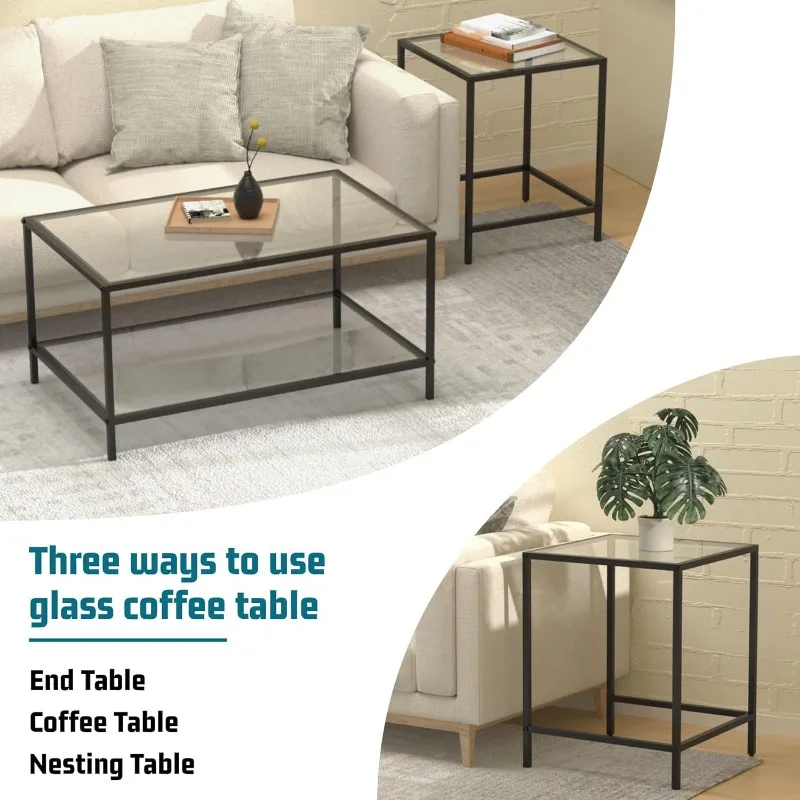
Organic and Biomorphic Shapes
Perhaps most distinctively mid-century are coffee tables with organic, biomorphic shapes that reference natural forms. These free-flowing, asymmetrical designs make bold statements and often function as sculptural art pieces within a space. When rendered in black, these distinctive silhouettes become even more dramatic, creating powerful focal points.
These statement pieces work best when given breathing room, allowing their unique forms to be fully appreciated. Their artistic nature connects directly to the mid-century appreciation for the integration of art and functionality.
Nesting and Tiered Tables
Nesting coffee tables offer practical versatility that aligns perfectly with mid-century values of functionality. Black nesting tables provide layered visual interest through their overlapping forms while offering flexible surface options that can be reconfigured as needed.
Tiered designs with multiple surface levels create opportunities for more complex styling arrangements while maintaining the clean-lined aesthetic of mid-century design. The varied heights create natural visual rhythm and offer practical separation of items displayed on the table.
When styling black mid-century coffee tables, the shape significantly influences the approach. Each form creates different opportunities for arrangement and display, affecting how the table integrates into the overall room composition.
Achieving Perfect Scale and Proportion
Getting the scale right is essential when incorporating a black coffee table into a mid-century interior. Because black can visually increase the perceived weight of furniture, paying careful attention to proportions becomes even more important.
The ideal coffee table height typically falls 1-2 inches below the seat height of your sofa cushions. This relationship ensures comfortable access from a seated position while maintaining visual harmony. For most mid-century sofas, this means a coffee table height between 16-18 inches.
Length proportions also matter significantly. A coffee table generally looks most balanced when it’s approximately two-thirds the length of your sofa. This proportion creates enough surface area for functionality while ensuring the table doesn’t overwhelm the seating arrangement. For example, a 72-inch sofa would pair well with a 48-inch coffee table.
Adequate clearance space is crucial for both visual breathing room and practical functionality. Allow 18-24 inches between your coffee table and surrounding seating to permit comfortable movement. This spacing creates an accessible flow while preventing the room from feeling cramped.
Black coffee tables tend to appear more substantial than lighter-colored counterparts of identical dimensions. This visual weight can be advantageous in large rooms with substantial furniture pieces but may require more careful consideration in compact spaces. To balance this effect, consider:
- Tables with exposed legs that create open space beneath
- Glass elements that reduce visual heaviness
- Slimmer profiles for table surfaces
- Rounded corners that visually reduce bulk
For smaller living areas, round coffee tables often work especially well as they eliminate sharp corners and improve traffic flow. Their continuous form occupies less visual space while maintaining functional surface area.
Proper proportion creates an immediate sense of intentionality in your design choices, making even bold elements like black coffee tables feel natural and harmonious within the space.
Styling Your Black Coffee Table: The Mid-Century Way
Styling a black coffee table within a mid-century modern interior requires thoughtful consideration of both form and function. The dark surface creates a dramatic canvas for carefully curated accessories that complement the overall aesthetic.
When selecting accessories for your black coffee table, embrace the mid-century philosophy of purposeful minimalism. Choose fewer, more significant pieces rather than cluttering the surface with small objects. Consider incorporating:
- Sculptural elements with organic shapes
- Books with distinctive spine colors or graphic covers
- Ceramics in earthy tones or bold period colors
- Warm metal accents in brass or copper
- Natural elements like wood or stone objects
- A single architectural plant like a small succulent arrangement
Material mixing creates compelling visual interest against a black table surface. The contrast of brass or copper accents can be particularly striking, adding warmth and luminosity that counterbalances the coolness of black. Textured ceramics in white or neutral tones pop dramatically against dark backgrounds, while wood elements maintain connection to the broader mid-century palette.
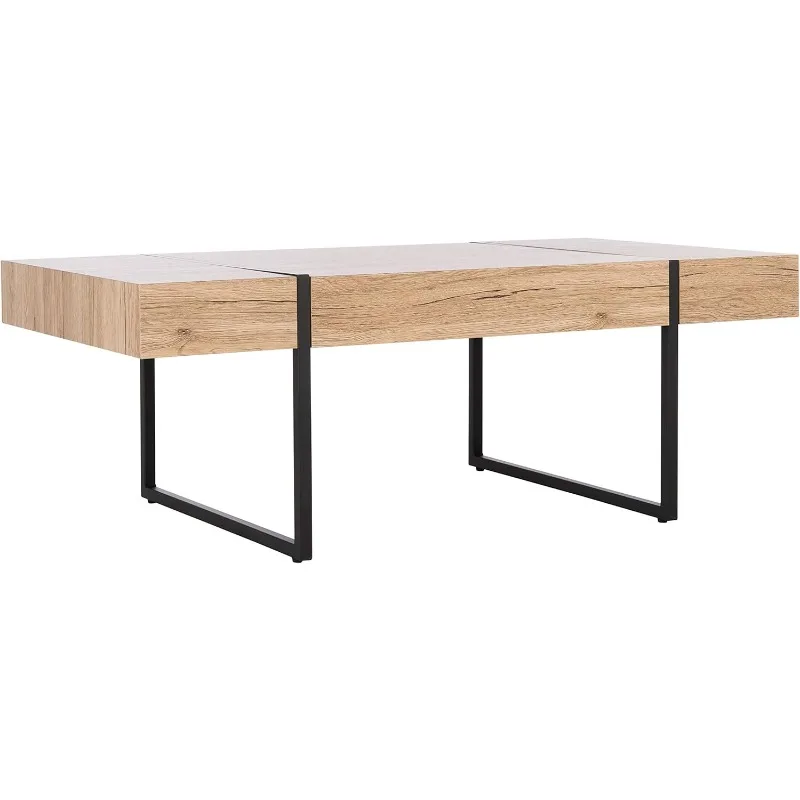
Balance and asymmetry play important roles in authentic mid-century styling. Rather than arranging objects in perfect symmetry, create intentional imbalance with varying heights and visual weights. This approach creates dynamic tension that draws the eye across the table surface. Consider the rule of thirds when placing objects rather than centering everything.
When decorating black mid-century coffee tables, remember that negative space is as important as the objects themselves. Allow portions of the black surface to remain visible, creating breathing room between carefully positioned elements. This restraint honors the mid-century value of letting each piece have its moment.
Color plays a crucial role when styling a black surface. Even small touches of color appear more vibrant against black, so use this to your advantage by incorporating strategic pops of mid-century hues like mustard yellow, teal, or burnt orange through small accessories.
Creating Cohesive Color Schemes Around Black
Developing a harmonious color palette around a black coffee table helps integrate it seamlessly into your mid-century interior. Black’s neutral nature allows for tremendous flexibility, but certain approaches work particularly well within mid-century contexts.
Monochromatic with Texture
A sophisticated approach pairs black with various shades of gray, white, and touches of silver or chrome. This restrained palette relies on textural variety to maintain visual interest. Consider:
- Charcoal textiles with visible weaves
- Nubby ivory throws
- Smooth white ceramics
- Ribbed glass accessories
- Brushed metal accents
This approach creates a gallery-like setting where the forms of your furniture become the stars, honoring the mid-century focus on shape and silhouette.
Warm Woods and Earthy Accents
Perhaps the most authentically mid-century approach combines black with warm wood tones and earthy accent colors. This palette might include:
- Walnut, teak, and oak furniture pieces
- Terracotta, olive, and mustard textiles
- Brass or copper lighting fixtures
- Natural fiber rugs in neutral tones
- Plants with varied foliage for organic green elements
This warm, grounded palette creates an inviting atmosphere that balances the coolness of black surfaces.
Classic Mid-Century Colors
For a more vivid interpretation, pair your black coffee table with the characteristic colors of the era:
- Teal blue upholstery
- Burnt orange accents
- Olive green textiles
- Mustard yellow decorative objects
- Ruby red small accessories
These distinctive colors gain sophistication when anchored by black elements, creating energetic yet balanced compositions that remain true to the period’s aesthetic.
When considering wall colors to complement a black coffee table, lighter tones often work best to prevent the space from feeling too dark or closed in. Warm whites, soft grays, or pale neutrals with subtle undertones create ideal backdrops that allow your furniture to stand out.
The principles of mid-century modern table design emphasize the thoughtful integration of each element into the whole. Your color scheme should create dialogue between your black coffee table and the surrounding furniture, with each piece contributing to a cohesive overall impression.
The Role of Lighting with Black Surfaces
Proper lighting plays a critical role when incorporating black coffee tables into mid-century interiors. The way light interacts with black surfaces creates both challenges and opportunities that require thoughtful consideration.
Black surfaces absorb rather than reflect light, which can make them appear as dark voids if not properly illuminated. Strategic lighting transforms this potential drawback into a design advantage by creating dramatic contrasts. Position floor or table lamps to cast directed light across the black surface, highlighting its form and any objects displayed upon it.
Different lighting temperatures significantly affect how black finishes appear. Cooler LED lighting (4000K+) can make black surfaces appear more starkly contemporary, while warmer lighting (2700-3000K) softens black’s intensity and better complements the warm woods typical in mid-century interiors. Adjustable lighting systems allow you to modify the mood as needed.
Reflections and glare require special attention with black tables, particularly those with glass or high-gloss surfaces. Position lighting to minimize uncomfortable glare while still adequately illuminating the table. Consider:
- Diffused overhead lighting rather than direct spotlights
- Adjustable-arm floor lamps that can be positioned precisely
- Table lamps with shades that direct light downward
- Ambient lighting that provides even illumination
Mid-century lighting styles that particularly complement black coffee tables include:
- Sputnik chandeliers with multiple light sources
- Articulating wall sconces that provide adjustable task lighting
- Arching floor lamps that curve over seating areas
- Mushroom table lamps with diffused light spread
Solid wood coffee tables with black finishes respond differently to light than glass or metal options, maintaining some warmth even in their darkened state. The subtle grain that often remains visible adds dimension under proper lighting, connecting these pieces to the broader material palette of the room.
Showcase: Black Coffee Tables in Diverse Mid-Century Settings
Black coffee tables demonstrate remarkable versatility across different interpretations of mid-century style. The following scenarios illustrate how these sophisticated pieces adapt to various design approaches while maintaining their distinctive impact.
Minimalist Mid-Century Setting
In a restrained, architecturally-focused space, a rectangular black coffee table with slim metal legs and a smoked glass top serves as a refined centerpiece. The room features:
- Clean-lined sofa in oatmeal bouclé fabric
- Pale ash wood accent chairs with minimal cushioning
- White walls with one concrete accent wall
- Architectural lighting with exposed bulbs
- Sparse accessories focused on form rather than color
- Single large-scale abstract artwork with geometric forms
The black coffee table anchors this understated palette, its reflective surface adding depth to the otherwise light composition. The table’s precise lines echo the architectural emphasis of the space while providing necessary contrast to prevent the room from feeling flat or sterile.
Warm Wood-Rich Environment
A round black coffee table crafted from ebonized walnut with tapered legs creates a perfect counterpoint in a wood-dominant space featuring:
- Teak wall paneling with vertical emphasis
- Cognac leather sofa with walnut frame
- Jute area rug in natural tone
- Woven pendant lighting with brass accents
- Terra cotta planters with trailing greenery
- Textural wall hangings in neutral fibers
Mid-Century Modern Solid Wood Coffee Tables, Mid-Century Modern Teak Coffee Tables
$879.95 Select options This product has multiple variants. The options may be chosen on the product pageMid-Century Modern Danish Coffee Tables, Mid-Century Modern Oval Coffee Tables, Mid-Century Modern Solid Wood Coffee Tables
$390.05 Select options This product has multiple variants. The options may be chosen on the product pageMid-Century Modern Glass Top Coffee Tables, Mid-Century Modern Glass Top Side & End Tables
$460.58 Select options This product has multiple variants. The options may be chosen on the product pageMid-Century Modern Glass Top Coffee Tables, Mid-Century Modern Vintage Coffee Tables, Mid-Century Modern Vintage Side & End Tables
$725.36 Select options This product has multiple variants. The options may be chosen on the product pageMid-Century Modern Nesting Coffee Tables, Mid-Century Modern Nesting Table Sets
$361.45 Select options This product has multiple variants. The options may be chosen on the product pageMid-Century Modern Oval Coffee Tables, Mid-Century Modern Solid Wood Coffee Tables
$679.56 Select options This product has multiple variants. The options may be chosen on the product page
This setting embraces the organic warmth characteristic of mid-century interiors while using the black table to prevent wood overload. The circular form softens the many straight lines present in the wood elements, creating welcome visual relief.
Bold Colorful Space
A rectangular black coffee table with solid wood construction and a matte finish grounds a vibrant room containing:
- Teal blue sectional sofa
- Mustard yellow accent chair
- Large-scale colorful geometric rug
- White walls serving as a neutral backdrop
- Statement lighting with brass components
- Collection of colorful art glass objects
- Bold abstract art with primary colors
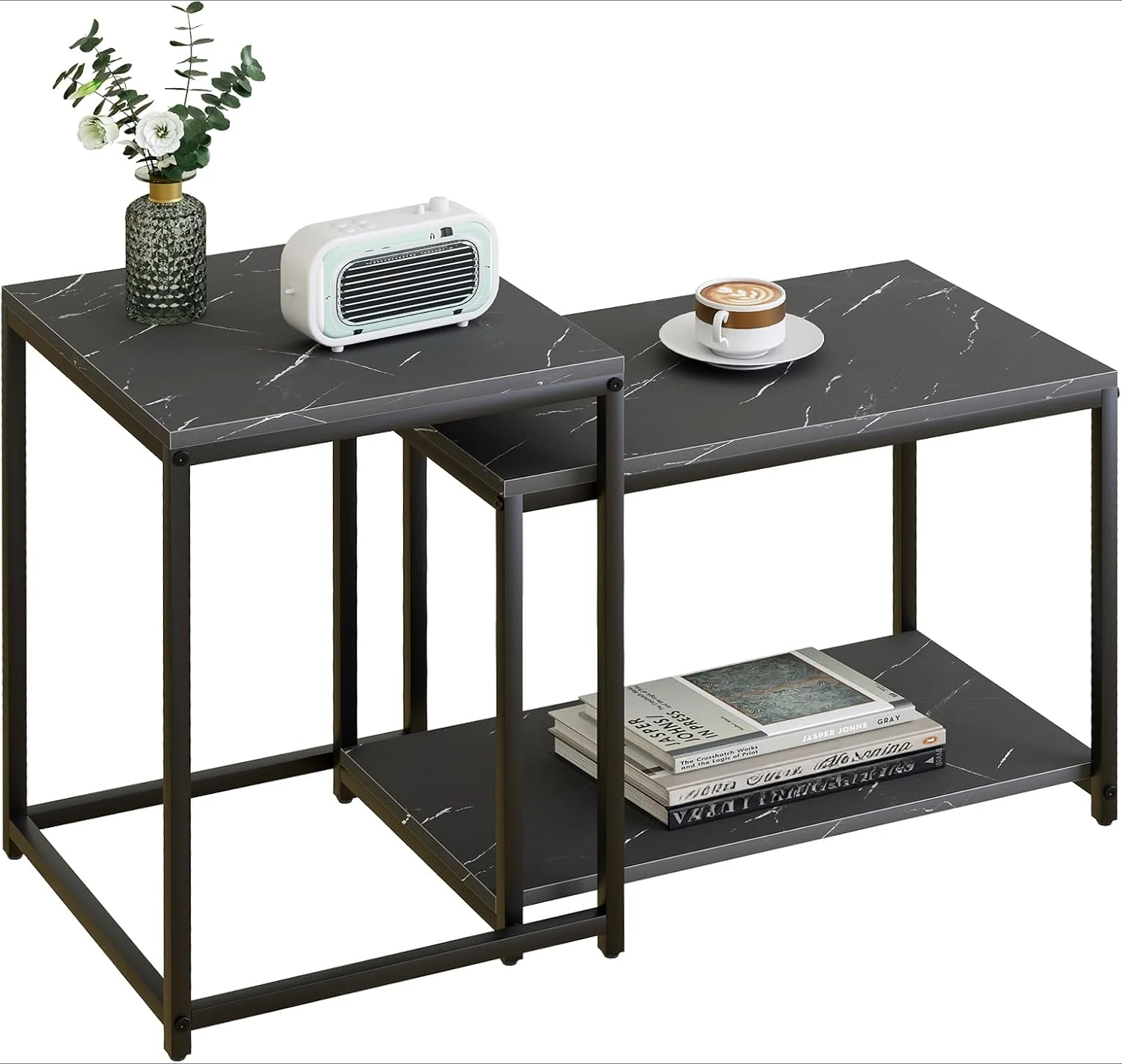
In this lively setting, the black coffee table provides a visual anchor that prevents the colorful elements from overwhelming the space. Its substantial presence creates a stable center around which the more expressive pieces can shine without competing with them.
These scenarios demonstrate how maximizing black mid-century coffee tables in different contexts creates distinctive atmospheres while maintaining design coherence. The common thread is how the black table provides definition and sophisticated contrast regardless of the surrounding palette.
Finding Your Perfect Black Mid-Century Coffee Table
Selecting the ideal black coffee table for your mid-century space involves navigating several considerations to ensure you find a piece that delivers both aesthetic satisfaction and practical functionality.
Authentic vs. Reproduction vs. Contemporary
When shopping for black mid-century coffee tables, you’ll encounter three main categories:
Authentic vintage pieces – Original tables from the 1940s-1970s offer genuine period character and often appreciate in value. However, they may require restoration, come with premium prices, and might show wear from decades of use.
Faithful reproductions – These pieces closely follow original mid-century designs while offering new materials and pristine condition. Quality varies significantly between manufacturers, so examine construction details carefully.
Mid-century inspired contemporary designs – Modern tables that incorporate mid-century elements while adapting to contemporary needs offer fresh interpretations of classic principles. These often provide the best value and practicality while maintaining the desired aesthetic.
Assessing Quality and Authenticity
When evaluating black coffee tables, look for these quality indicators:
- Solid wood construction rather than veneers over particleboard
- Joinery that uses traditional techniques like dovetail or mortise-and-tenon
- Even, well-executed finishes without bubbling or inconsistencies
- Proper weight that indicates substantial materials
- Stability without wobbling or creaking
- Smooth-operating drawers or doors if the piece has storage features
For reproductions claiming to follow specific designers’ work, research the original designs to ensure proportions and details are accurately represented.
Investment Considerations
Black coffee tables in authentic mid-century style often represent significant investments. Consider these factors:
- Higher quality pieces generally retain value better than budget options
- Iconic designs or pieces by recognized designers typically appreciate over time
- Versatile shapes and sizes will serve you longer as your needs change
- Durability of materials and construction affects long-term value
- Timeless designs will outlast trend-driven variations
The right black coffee table should be viewed as a long-term addition to your home rather than a temporary solution, making quality and design integrity worth prioritizing.
Care and Maintenance for Lasting Beauty
Maintaining your black coffee table’s appearance ensures it remains a stunning focal point in your mid-century interior for years to come. Different materials require specific approaches to cleaning and protection.
Wood Care
For ebonized or black-stained wood tables:
- Dust regularly with a soft, lint-free cloth
- Clean with a barely damp cloth followed immediately by a dry cloth
- Apply furniture wax specifically formulated for dark woods every 6-12 months
- Use coasters to prevent water rings and heat marks
- Position away from direct sunlight to prevent fading
- Handle spills immediately to prevent staining
Metal Maintenance
For black metal components:
- Wipe with a soft cloth to remove dust and fingerprints
- Clean with a mild solution of dish soap and water when needed
- Dry thoroughly to prevent water spots
- Apply a thin coat of paste wax annually to maintain finish
- Touch up any chips promptly to prevent rust or corrosion
- Use felt pads under objects to prevent scratching
Glass Surface Care
For black or smoked glass surfaces:
- Use glass cleaner applied to a cloth (not directly to glass) to prevent dripping
- Microfiber cloths work best for streak-free results
- Clean fingerprints weekly for best appearance
- Use placemats or coasters to prevent scratches
- Lift rather than slide objects across the surface
- Check and tighten any hardware that secures glass regularly
Stone Maintenance
For black marble or stone tops:
- Ensure your stone is properly sealed initially and re-seal annually
- Clean with stone-specific products rather than general cleaners
- Wipe spills immediately, especially acidic substances like wine or citrus
- Use coasters and placemats to protect the surface
- Dust regularly with a soft cloth
- Avoid placing extremely hot items directly on stone
Black furniture does tend to show dust more readily than lighter pieces. Establishing a quick daily dusting routine with a microfiber cloth helps maintain its best appearance with minimal effort.
Why Black Coffee Tables Remain Timeless in Mid-Century Design
The enduring appeal of black coffee tables in mid-century modern interiors speaks to their remarkable versatility and design integrity. These pieces transcend passing trends through their ability to balance visual weight, provide sophisticated contrast, and highlight the clean lines that define mid-century style.
The successful integration of a black coffee table into your mid-century space relies on thoughtful consideration of scale, material, and surrounding elements. When these aspects align harmoniously, the result is a living environment that feels both authentic to mid-century principles and freshly relevant to contemporary life.
What makes these pieces particularly valuable is their ability to evolve with your space over time. As textiles, wall colors, and accessories change, a well-designed black coffee table maintains its foundational role, adapting effortlessly to new surroundings while providing consistent visual anchoring.
Making this bold design choice represents confidence in timeless principles rather than temporary fashions. The sophisticated drama of black within the warm, organic context of mid-century design creates a dynamic tension that energizes a space with visual interest that sustains engagement long after trend-driven choices would have faded from favor.
As you consider incorporating a black coffee table into your own mid-century inspired space, remember that its impact extends beyond mere function. These pieces serve as artistic statements that reflect the thoughtful integration of form, material, and purpose that makes mid-century design continuously relevant and deeply satisfying.

